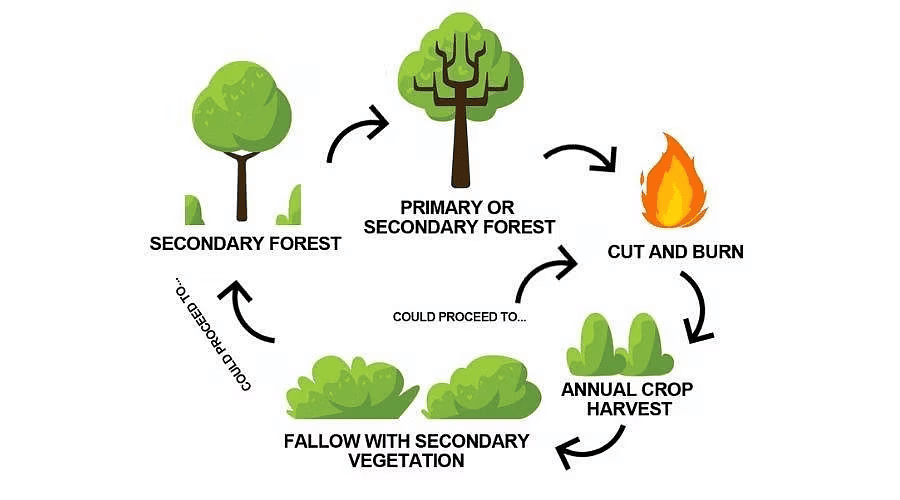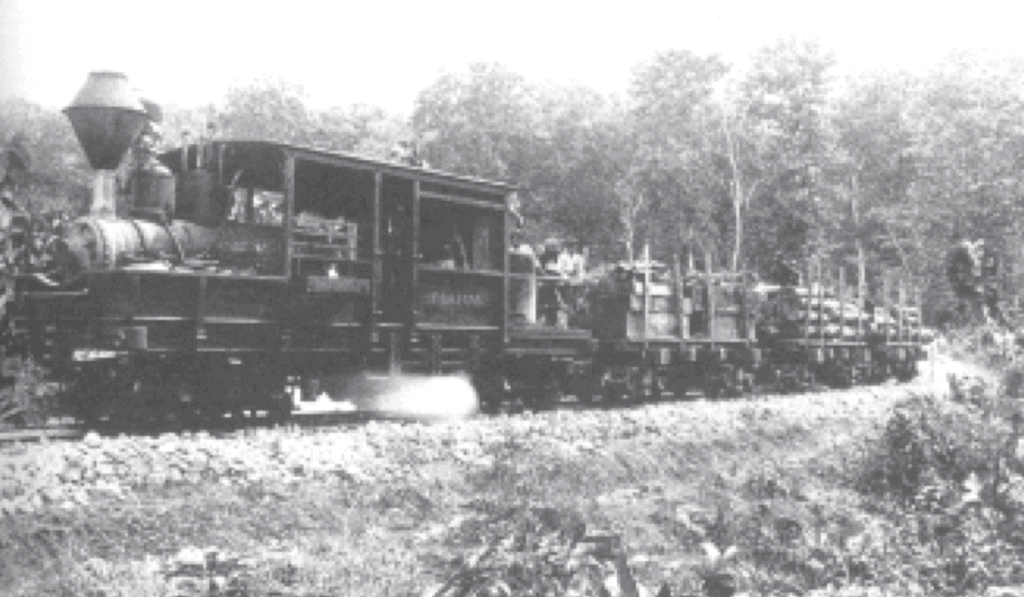Class 9 History Chapter 4 Question Answers - Forest Society and Colonialism
Q1. What is deforestation? Why is it considered harmful?
Ans: Deforestation means cutting down or clearing forests, usually for farming, building industries, or using wood for fuel.
It is harmful because:
- Forests give us paper, wood, spices, oil, and medicinal plants.
- They are home to many animals and birds.
- Forests prevent soil erosion and help maintain the balance of nature.
- They help in maintaining ecological diversity and clean air.
So, deforestation damages the environment and harms wildlife and humans.
Q2. Describe scientific forestry.
Ans: Scientific forestry was a method used by the British to manage forests in a planned way.
- Old trees were cut and new ones were planted by the forest department.
- Natural forests with many species were replaced with only one type of tree (monoculture), planted in straight rows.
- Forest officials made working plans to decide how much forest could be cut each year.
- Forest areas were surveyed and managed carefully.
- Cleared areas were replanted for future use.
This system focused only on timber production, not on the needs of forest dwellers.
Q3. What were the different forest acts made by the British to control the forests?
Ans: The British made several laws to control forests:
- 1864: The Indian Forest Service was established.
- 1865: The Indian Forest Act was passed to regulate forest use.
- 1878: The Act was amended. Forests were divided into three categories:
- Reserved Forests: Most restricted, people were not allowed to take anything.
- Protected Forests: Some limited use was allowed.
- Village Forests: Forests for local village use. - 1927: The Indian Forest Act was revised again to strengthen British control.
These acts reduced the rights of villagers over forest resources.
Q4. What is shifting agriculture? Why was it regarded as harmful by the British?
Ans: Shifting agriculture (also called jhum, podu, etc.) is a traditional farming method where:
- Forests are cleared by cutting and burning trees.
- Seeds are sown in the ash-rich soil after the monsoon.
- After a few years, the land is left fallow for the forest to grow back.
The British thought it was harmful because:
- It could not grow trees needed for railway timber.
- Burning trees might cause forest fires.
- It made tax collection difficult.
So, they banned shifting cultivation and displaced many forest communities.

Q5. Explain why the Dutch adopted the ‘scorched earth policy’ during the war.
Ans: The Dutch used the scorched earth policy in Java before the Japanese invasion during World War II.
- They burnt sawmills and huge teak log piles to stop the Japanese from using them.
- It was done to deny timber, a key war resource, to the enemy.
- After the Dutch left, the Japanese used forest villagers to cut down trees.
- Many villagers also used this time to increase farming, leading to later conflicts with the forest department.
Q6. How did the forest rules affect cultivation?
Ans: Forest rules significantly impacted cultivation practices, particularly shifting cultivation.
- Shifting cultivation involves clearing forest areas, burning them, and planting seeds in the ashes.
- This method relies on rain for irrigation and allows the land to rest for several years.
- Colonial governments viewed this practice as harmful, complicating tax assessments.
- As a result, they imposed bans on shifting cultivation, leading to the displacement of communities.
- Many communities were forced to change their livelihoods or resist through rebellions.
Q7. Why did land under cultivation increase during colonial rule?
Ans: The increase in land under cultivation during colonial rule can be attributed to several factors:
- The British promoted the growth of cash crops such as jute, indigo, and cotton to meet economic demands.
- Food crop cultivation was encouraged to ensure food security for the population.
- Forests were viewed as unproductive, leading to significant clearing for agricultural use.
- This expansion aimed to enhance revenue and economic output for the colonial government.
Q8. What did Dietrich Brandis suggest for the improvement of forests in India?

Ans: Dietrich Brandis, a German forester, made several suggestions to manage Indian forests better:
- Protect forests from over-cutting and grazing.
- Start a trained forest service – the Indian Forest Service was formed in 1864.
- Introduce forest laws – the Indian Forest Act was passed in 1865.
- Promote scientific forestry to ensure careful cutting and replanting of trees.
Q9. What was taught at the Imperial Forest Research Institute? How was this system carried out?
Ans: At the Imperial Forest Research Institute (established in 1906 in Dehradun), officials were trained in scientific forestry. This system included:
- Replacing natural forests with monoculture plantations (only one type of tree, like teak).
- Forest officers planned cutting cycles and measured tree types and areas.
- The cut area was replanted, so it could be used again after a few years.
- The aim was to increase timber production for railways and ships.
Q10. Differentiate between the customary practice of hunting and hunting as a sport in India, after the Forest Acts were passed.
Ans:
Before the Forest Acts:
- Local communities hunted birds and small animals for sustenance.
- This customary practice was prohibited by the new forest laws.
- Those caught hunting faced punishment for poaching.
After the Forest Acts:
- Hunting big game became a recreational sport.
- Colonial authorities promoted large-scale hunting, leading to the extinction of many species.
- Exclusive hunting areas were created, with rewards for killing predators seen as threats to humans.
- Over 80,000 tigers, 150,000 leopards, and 200,000 wolves were killed between 1875 and 1925.
- The tiger evolved into a sporting trophy, with notable figures like the Maharaja of Sarguja shooting over 1,157 tigers.
Q11. With the help of an example, show how new opportunities of work did not always mean improved conditions of the people during colonial times.
Ans: New jobs under British rule often made people’s lives harder. For example:
- In Assam, people from tribal communities like Santhals, Oraons, and Gonds were recruited to work in tea plantations.
- They were paid very low wages and had to live in poor conditions.
- They had no freedom to return to their villages easily.
- So, even though they had jobs, their lives did not improve.
Q12. How did the spread of railways from the 1850s in India create a new demand for timber?
OR
Why was the railway network spread by the British in India from 1850s onwards? Why was there a need for forest timber spread for railways?
Ans: The railway network created a huge demand for forest timber because:
- Timber was used as fuel for steam engines.
- Wooden sleepers were needed to hold the tracks in place – about 2,000 sleepers per mile.
- As railways expanded quickly, more trees were cut to meet the timber needs.
- The British gave contracts to private suppliers, who cut down trees in large numbers.
For example, in the Madras Presidency, about 35,000 trees were cut every year in the 1850s for railway sleepers.
 Train transporting teak out of the forest
Train transporting teak out of the forest
Q13. Why were the people of Bastar dissatisfied with the forest policies of the British?
Ans: The people of Bastar were unhappy with British forest policies because:
- Two-thirds of the forests were declared reserved, and people lost access.
- Shifting cultivation, hunting, and collecting forest produce were banned.
- Many villagers were displaced without any compensation.
- Rents were increased, and people were forced to give free labour and goods.
- The region also faced famines in 1899–1900 and 1907–1908, worsening their situation.
Q14. Who were the Kalangs? Why did they attack the Dutch forts at Joana?
Ans:
The Kalangs were a skilled forest community in Java, known for cutting trees and shifting cultivation.
They were important for teak harvesting used in building ships and houses.
In 1770, when the Dutch tried to control them and force them into labour, the Kalangs rebelled and attacked the Dutch fort at Joana.
Q15. What were the consequences of the forest laws which the Dutch enacted in Java?
Ans: The Dutch forest laws in Java had the following effects:
Villagers could only cut wood from selected forests for specific purposes.
Grazing cattle, transporting wood, or using forest roads without permission led to punishment.
Traditional practices like shifting cultivation and free forest use were restricted, causing hardship for local people.
Q16. Discuss the link between war and deforestation.
OR
Give three ways in which forests in India and Java were affected by the first and second world wars.
Ans: Wars led to large-scale deforestation in India and Java:
- In India, forests were cut freely to meet British war needs during World Wars.
- In Java, the Dutch followed a scorched earth policy, burning sawmills and teak logs before Japanese occupation.
- The Japanese exploited forests heavily for military use, and many villagers cut trees to expand cultivation.
Q17. Mention any three causes of deforestation in India under colonial rule.
Ans: Three major causes of deforestation under British rule were:
- Commercial farming: Forests were cleared to grow cash crops like jute, sugar, and cotton for export.
- Railway expansion: Wood was needed for sleepers and fuel, leading to massive tree cutting.
- Plantations: Natural forests were cleared to set up tea, coffee, and rubber plantations by European planters.
Q18. What were the three categories of the forest that were divided after the amendment of the Forest Act in 1878 in India?
Ans: The three categories of forests established after the amendment of the Forest Act in 1878 were:
- Reserved forests: These were the best forests, where villagers were not allowed to take any resources.
- Protected forests: Villagers could use resources from these forests for their needs.
- Village forests: Similar to protected forests, villagers could collect wood and other materials for personal use.
In summary, villagers could only take wood from protected and village forests for building houses or fuel.
Q19. Discuss in brief the Saminist movement of Indonesia.
Ans:
The Saminist movement was started by Surontiko Samin in Java in the late 19th century.
He opposed Dutch control over forests, saying that natural resources should not belong to the state.
Many villagers joined him, refusing to pay taxes or follow forest laws.
Though the Dutch tried to suppress it, the movement became a symbol of resistance against colonial rule.
Q20. What was the impact of the regulation of trade in forest products by the British government in India?
Ans: The British regulation of forest trade had several negative effects on local communities:
- Strict control was imposed over the use and sale of forest products.
- Grazing, hunting, and collecting forest produce were restricted.
- Communities like the Korava, Karacha, and Yerukula in the Madras Presidency lost their traditional livelihoods.
- Many were unfairly labelled as ‘criminal tribes’ and forced into low-paying jobs in factories, mines, and plantations.
- In Assam, forest groups like the Santhals, Oraons, and Gonds were forced to work on tea plantations under poor conditions and low wages.
- These workers found it difficult to return to their home villages.
Q21. In what ways did the development of railways and shipbuilding during colonial rule affect the forests in India?
Ans:
Railways:
- Deforestation: The construction of railways required clearing large areas of forest.
- Land Clearing: Forests were removed to lay railway tracks across India.
- Timber Demand: Locomotives needed wood for fuel and sleepers.
- Indiscriminate Logging: Contractors cut down trees without considering sustainability.
Shipbuilding:
- Wooden Ships: In the early 19th century, ships were mainly made from wood, especially oak.
- British Naval Needs: The Royal Navy required wooden ships to maintain colonial power.
- Impact on Oak Forests: Extensive oak forests in England were depleted to meet naval demands.
- Colonial Exploitation: To address timber shortages, the British exploited forests in India.
- Massive Deforestation: Colonial policies led to significant loss of forest areas.
Q22. What was the Blandongdiensten system?
Ans: The Blandongdiensten system was introduced by the Dutch in Java to get free labour for timber extraction. Its features:
- Villagers in forest areas had to pay land rent.
- They could avoid paying rent by giving free labour and buffaloes for cutting and transporting timber.
- Later, instead of rent exemption, small wages were given.
- However, villagers lost their rights to freely use forest land.
- It helped the Dutch get large amounts of timber for ships and railways.
Q23. What are the new developments in forestry?
Ans: Since the 1980s, forestry has shifted from control to conservation:
- Scientific forestry is being re-evaluated to include local community participation.
- Focus has shifted from just cutting timber to conserving forests.
- In areas like Mizoram and Kerala, communities protect forests through sacred groves (called sarnas, devarakudu, kan, rai, etc.).
- In many villages, people take turns patrolling forests to protect them.
- Environmentalists and villagers now work together to find better forest management methods.
|
55 videos|525 docs|78 tests
|
FAQs on Class 9 History Chapter 4 Question Answers - Forest Society and Colonialism
| 1. What impact did colonialism have on forest societies? |  |
| 2. How did forest societies adapt to colonial rule? |  |
| 3. What role did forests play in the lives of indigenous communities before colonialism? |  |
| 4. What were the main policies implemented by colonial powers regarding forests? |  |
| 5. How can understanding the relationship between forest societies and colonialism help in current environmental conservation efforts? |  |

















